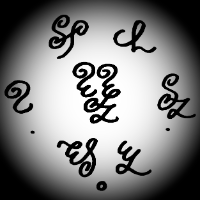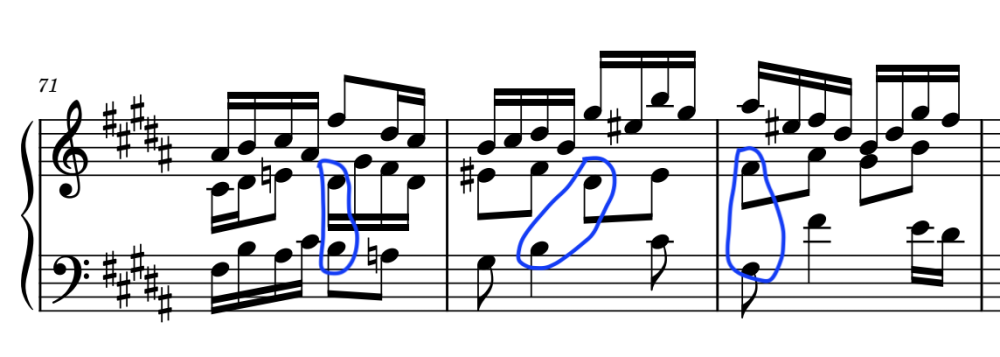Leaderboard
Popular Content
Showing content with the highest reputation on 04/08/2025 in all areas
-
Hello @Aleon Raven, Welcome to the forum! The track, like @PeterthePapercomPoser said, is varied, intense and mesmerising! I especially love your usage of voice here. I like in 2:20 you go for more contemplative passages, first with a solo violin, then with vocals. These really give contrast to previous passages. The modulation to one key higher is a standard technique in film music to heighten the drama, but I don’t mind here as it is in my favourite C sharp minor haha. The last decresendo is lovely too, esp. with the piano and harp here. The music reminds me of fellow member @olivercomposer’s film music posted here and you may check them out. Btw, I also like the visual effect here! Thx for joining and sharing your music here! Henry2 points
-
Thank you very much. I find it surprising that I've managed to make it more palatable to the ear than some other denser fugues of mine, but like you say it is only the masters that know how to manage contrapuntal density, Fortspinnung and diversity of approaches towards the simplest materials to grant their usage in each given piece the pinnacle of transformative richness. Those are abilities I still need a long time of honing and perfecting my craft and skills in order to acquire, let alone take them to the same level of greatness as our mighty forefathers. To be honest, I'm not so sure I agree with you here. Let's assume we did in fact exchange and cross voices at the points you noted: just in the first measure, we would have to make a descending tritone leap, and the rising bass from the lower F-sharp to the higher G-sharp in the 3rd beat/1st part of the 2nd beat in what is currently the middle voice would gives us a span larger than an octave in a continuous rising melody, which makes even less sense to me. Even if we take the twist the bass makes in the 2nd beat (rising to B and then descending to A-sharp before rising again) we would still have the melodic span of a major 7th in a non-chordal arrangement (A# C# D# G# instead of A# C# E G#, as would be more expected and acceptable in my opinion). Just now, after revising it again, I have made some changes to the bass and middle voice in b. 73 as follows (as well as adding an A-sharp so as to avoid parallel fifths between the middle and upper voices in the weak 16th-notes of the 2nd beat). I also slightly altered the upper voicing of the supertonic dominant chord before the finale for slightly more rhythmic variety. Regardless, thank you for your remarks, for even if the ones you made didn't make it into this (hopefully final) version, it certainly did make me come back and check for other potential mistakes, which I did end up finding and thus, correcting. 🙂1 point
-
It sounds really delicious. The baroque counterpoint is fantastic. I love that you like to compose in that style. Sometimes there are fugues that “tire me out” but sometimes the opposite. Of course, I don't get tired of those of the great composers, haha. This one either, to be honest. Regarding what has been said about the tenths, I think it is common practice (and one of the difficulties in the interpretation) to cross the hand notes, although it is not indicated in the score, probably because in baroque the clarity of each voice predominates, not so in romanticism where these things are noted due to the density of texture. Greetings.1 point
-
Indeed, that is how I feel about it. Had I got discouraged by my initial lack of skill and abundant contrapuntal mistakes from the get go, I would have ended up disheartened and giving up on composition entirely. My career would simply had died before it could have even started, and I wouldn't have enjoyed composing so many of my fugues, as I set out to do from the very beginning. Regarding the 10ths in b. 71~73, the latest edition has those corrected alongside some minor voicing changes here and there as well. Thank you for your criticism and kind words, Henry 🙂1 point
-
That’s the most important thing: every composers must be much less skilled in their first compositions, and noticing how bad they are actually prove how much you have improved, instead of having the same work as your “masterpiece” in all those years. I have listened to the original piece, and believe me it isn’t as bad as you think, it’s a great effort for a blossoming composer. Trying with tons of error will be much better than trying to be perfect in your head and afraid to have a single error in your work, because only writing with errors and spotting them help you improve, which your present day compositions prove it. Henry1 point
-
The main issue with transposing the bass an octave upwards between said bars so as to avoid the excessive distances found between all three voices is melodic coherence: in order to keep the bass line as melodically stable as possible in order to avoid uncomfortable leaps or clashes with the middle voice, the whole line had to stay in the lower octave. Still, I should probably look into it again so as to maybe find a potential workaround. For context, here's a link to the version first published in the original post: As you can most likely tell, my counterpoint back then was simply just deplorable. The last commenter was exceptionally kind with their review, given how terribly the rules of counterpoint and mandatory resolutions were handled, plus how awfully disappointing the structure and scant usage of actual contrapuntal devices both were (a general trait unfortunately carried over into the final revamp, save perhaps for the last-time addition of a false entry in b. 81~82). If I recall correctly, I was barely 14 at the time, and after listening to Bach's Kunst der Fuge in its entirety during the late Summer, I decided to try my hand at writing something in his style, perhaps as a way of channeling the mind-bending awe and admiration I felt for the Master's work, or maybe as a rather childish experiment that wouldn't carry over beyond the realm of first-time mediocrity. In spite of how bad my first pieces were, I decided to press on, still knowing my "music" at the time was far less than subpar at best, with a sense of humility, receptiveness and self-improvement to which I owe the place my skills currently stand at. And believe me, as evident as it is from the score in the original post from that year, if you think your counterpoint after composing for 10 years was "worse as shxt", then mine must have been at least 10 times worse than that! As much as I now absolutely loathe the lack of skills in counterpoint my pieces used to display back then, and usually (for the most part) can't stand to look back at my oldest compositions, I still cherish the innocence and naivity from which it all started and came from, which is why I still keep those fugal abominations in a dedicated trash folder instead of deleting them for good: to always keep reminding myself that I too was once nothing but a humble and ignorant novice in the myriad complexities of this vast world that is musical composition.1 point
-
So this is the final draft of the entire 2nd movement of my String Sextet. I can confidently say this is my best movement of music ever written up to date. The movement is divided into three parts: Lamentoso, Fugue a6 and the Return. The first two parts of the movements have been posted before in below links: Lamentoso: Fugue a6: If you want to skip to the newest content I compose, you may skip to 20:16. The musical analysis of the Lamentoso and Fugue have already been done in the link posted above so I won’t repeat it here. Here is the YT link and score of the movement: (Final Draft) String Sextet 2nd mov with last page.pdf Here is the YC post to the first mov of the same Sextet: Here is the structure of the movement: 00:00 Lamentoso The Eden in the 1st mov is great but man, come on and live in the real world. All sorts of tragedies happening and what ground do you have to claim the transcendence? I especially love the outburst in 4:59 and the passage starts from 8:53. 11:47 Fugue a6. This part is totally inspired by Vince’s @Thatguy v2.0 comment on my first movement “to write a dense fugue”, also to further explore the fugato in the 1st mov. Like @Giacomo925 said, this part summarises the sadness of the first 20 minutes of the movement. It always leaves me in awe that my favorite C minor passage, the absolute climax of the whole piece, lies in minute 30 exactly. The fugue aims to end on desperate terms but I won’t allow it. I try to give it a fight by recalling the pentatonic ideal even though in the wrong key of the tritone C major as hinted in the pentatonic section of the fugue, but the power is diminished. I need some purification for the paradise regained. Thx to @Luis Hernándezfor introducing me to tritone substitution in this part. The chant (22:01) begins with self murmuring of viola, occasionally inviting mysticism recalling 7:55 in Lamentoso and sadness of the 1st subject of the fugue. Two violas play together with the texture of a parallel organum. After a sad cry some more primitive power comes in to recall the passion and good of human beings, the theme is from b.27 of 1st mov. It gets agitated and experiences an epiphany in the form of Bartok Pizz. Both the chant and the folk melody is built around the 025 set! And the 025 set is the essence of the pentatonic scale! Furthermore a quartal chord is the further essence of 025 set, and hence the core of the whole pentatonic scale! Discovering this, the fury cannot be stopped. It leaves me in wonder how on earth can I write this thing out. After returning to the tonic key in 27:00, I decided to conceive it as a one off climax with build up. The idea is inspired by my playing of Beethoven’s op.110 when he did the same thing in the last movement as well. There is no “development” but only realisation of Tao in this imperfect world. There are appetizers to the ultra climax, first introducing the two most important themes sparingly, then in 27:16 theme in b.35 of 1st mov which is in fact inspired by my own Clarinet Quintet in C minor, and then an appetizer fugato responding to the lament in b.148 of the Lamentoso which is based on the opening theme. The entrée of Ultra Climax appears in 28:38, first is the first theme in tonic by first violin, viola, and cello, then second theme in C major by second violin, viola and cello. The playing of tritone is to prove Tao‘s omnipotence, also respond to the first mov and the fugue with the F# and C minor relationship. Using all 3 instruments for me is the resonance of Heaven, Earth and Human when they finally sing together the Tao they shared. I think I really feel the Chinese philosopher Tang Chun-i’s Realm of Heavenly Morality here. The modulation to Ab major, responding to b. 294 and 644 of 1st mov, complete what’s left undone there and finally Gb major is in triumph. A pedal point on a tritone is funny for me. The cello overlapping the violin is signifying earth and heaven interaction which is considered auspicious in Chinese classics I-ching. I am always in awe of the power exhibited here and wonder who’s actually the composer of this passage. The next passage in 30:07 is the heterophonic version of the 1st theme, which is where I was inspired miraculously by a Chinese music group. Next is the in extremis passage in 30:57. It’s the immanent version of the 1st theme. I was imagining what my friend’s thinking on his last day of life. The texture is probably inspired by the film music in Kurosawa’s Ikiru when the main character was swinging on the park’s swing to await his death. I quote Bach’s St. John Passion here for my friend’s name, and I find out that the lyrics fit too. I wish him to rest in peace and return to Tao. The final ending is probably inspired by the ending of Chopin’s Fantasie in F minor. I can never believe I would end the whole thing this positive in an absolute way. The whole passage always leaves me in tears. After writing the Lamentoso in May 2024 I had no power and inspiration at all to write anything in the Sextet since I was suffering in my full time job. I started picking up by working on the C# minor Piano Sonata first. After finishing that in Jan 2025 I felt like my negative power was expressed out, leaving the goods for this Sextet. I then went for a walk on 10 Feb 2025 and had a miracle, inspired by a Chinese music group, which turned on my creative power and I fervently completed the entire thing in just 18 days, when I had zero notes written in the past 9 months. It’s such a miracle I could have finished this piece this quick and good. My dedicatee Mr. Johnson Ho had already passed away last year. It's a shame that this piece couldn’t be completed when he’s alive, but I would be forever thankful for his inspiration. Special thanks must have been granted to my great friend Mr. Vince Meyer @Thatguy v2.0 for making this perfect audio and many ideas, and being a great friend, but I will leave it to the final version of the whole Sextet. Also a very special thanks must be given to my ex-boss. Thanks to her mistreatment, I have the pain to reflect on my own, the drive to finish the whole Sextet in a fury and the time to complete it when I was forced to resign for my own mental health. Foremost of course I must thank my dearest mum. But lol, the whole acknowledgement will be left to the post of the final version of the whole Sextet, including the first movement and this movement. This is a very long movement and commentary and I don’t expect anyone to listen and read till the end. But if you do so, here is my deepest gratitude to you. Feel free to comment as well, I would be very thankful to have received them. Thank you!!!!! Henry1 point
-
Hey Peter, It always happens to me lol! Yup I need a bleak opening to counter the hyper-for-nothing ending of the first movement and reminds myself what’s happening in the world now. I love hyper motivic, it’s the easiest way to compose for me haha! And you are very acute to point up that the Tranquillo foreshadows the Religioso. In fact, I had the idea for Religioso earlier than the Tranquillo, and I told myself I need some foreshadowing of it before the fugue, otherwise it would sound odd and incoherent for me! I love the Mesto section myself! Yup I have mentioned before, I learn from Mozart’s fugue for two pianos for the constant dissonances of false relation for a subject entry. Btw, don’t link me with that bad man lol! I don’t know what that bad man had in his mind, but for my part, that 6 part fugue is technically the most difficult thing I have ever written. That said, it’s actually the easiest part to write in the entire 2nd movement because you’re just need to follow the rules, even though a tedious one, but other parts take hearts and soul to finish. For the pentatonic figures, since I know the whole structure of the piece, I think I must invite some pentatonic foreshadowing in the fugue section before getting to the pentatonic proper later in the final part of the piece, as this would make the structure much more reasonable! Wow I forget the term Metric Modulation since out of the university, thx for reminding haha! I really have something pious in my mind, though not related to any religions. And that on beat switch actually creates another layer of rhythmic dissonance so it’s good! Yup, it resonates b. 159 like @Fugax Contrapunctus said and foreshadow the last bar of the piece. It signifies the frog croak of heart. Yeah the energy is overflowing which even shocks me. The in extremis section is always my favourite section, so complicated in the emotion. And I love the pizz. gliss ending too, sounds philosophical to me and definitely not as bleak as the ending of Sibelius 1st Symphony. To be honest, I don’t know where will I go. Just like after I finished my Clarinet Quintet, I would never imagine writing this Sextet and finish it much better than the Quintet, I will just keep exploring. Short term projects would be for shorter and simpler pieces for relaxation. Thx! Henry1 point
-
Hey Pabio, How the hell for me not to reply this amazing review??!! Thx for your compliments man! Yeah I have stopped trying to find my style now. Maybe my style is combining many styles eclectically together like a curator and use them in their own places, I really don’t know haha. I always use motives since for me it!s the easiest way to compose, I can always copy and paste! But seriously, coherence is so important to every pieces of music. That is always the most important aspect for me in music. Yup that parallel fifth is a resonance to the opening of the 1st movement which also has parallel fifth. The avoidance of parallel is just to avoid the dependence of voices and that crude parallel sound, but these things are what I want here! I ALWAYS love a Phrygian cadence on C sharp minor, so beautiful. I like some of the Spanish music or Tango music because of that! Thx! I did pay some hard work for coherence by varying existing materials, I think that’s my way of composing since it’s the easiest for me haha! Believe me, the 3rd movement would be the best out of the 3 movements in the Sonata, though it is hard to play and I need some time to practice! 😄 Henry1 point
-
This one is definitely easier to digest, as I do that in my posts haha, and a double benefit for using the video on YouTube too. I like this final final draft haha, Henry1 point
-
Hey Pabio @Fugax Contrapunctus! I have never heard of your first version but this revised sounds nice for me. Just beware of b.71 to 73 when there are tenths which would not be playable for most pianists! It sounds amazing to me that you already tried to compose a Fugue while only composed for few months; I never had that courage until composing for 10 years or so! And I’m sure my counterpoint back then was worse as shxt. Thx for sharing! Henry1 point
-
I think this one sounds better. I always hear from our master orchestrator @gmm here how good Spitfire’s Instruments sound like. Thx for update! Henry1 point
-
It sounds quite nice. I like it. I like the counterpoint really much. You definitely really spiced up the major which I’m really happy about as that just using the major scale by itself can be really bland. Sometimes I also heard some theme that sounds a bit like “deck the Halls.”1 point
-
Hi Luis @Luis Hernández, This one is amazingly composed and looks very wonderful. Your post is wonderful too. Bach's interest in his late period into canons is always wonderful and so glad he did that. Thx for sharing your music and post! Henry1 point
-
I think this is a case of something that should be very subtle being made obvious by the fact that all the instruments are doing it all at once. And I don't really consider my ears to be that much better than average on here. Perhaps I've been a bit sensitized to the effect because the new version of discord makes music being played or any sounds being made by your computer temporarily quieter in order to clearly play its notification sound. So for a second there I thought discord was going to play a notification when I heard that dip in volume at 3:28. Thanks for your reply!1 point
-
Oh I didn't realize you were using notation software for all of this. I use Sibelius, and am unfamiliar with musescore, but can you use dynamic markers for different staves? A performer would know to bring out the RH, but in Sibelius you can write mf for the treble and p for the LH for example. Maybe something like that could work? You might have to make adjustments during the piece if that's the case, but what the score looks like for computer performance versus what it would like for a pianist might be different.1 point
-
Yes, I understand the intent of the strings. Perhaps, in a case like this, where they have a predominantly harmonic support role, I would have opted for fewer lines (here there are five in the strings if I'm not mistaken). But it's a choice, of course. I seem to recall Rautavaara doing something similar in the Piano Concerto No. 3, and it's fascinating. That musescore function is very handy, the program I use (which I'm very used to, doesn't do it and I have to put the videos together myself). I usually put here the two versions, the video-youtube version, and the pdf with mp3. If I don't upload the video, then only pdf + mp3. Everything is fine.1 point
-
Hello @Aleon Raven and welcome to the forum! What an intense, lucid and mesmerizing track! It starts very underwhelmingly and takes its time to build up to full intensity. I love how hypnotic the ostinato pattern makes the whole track. And there's plenty of variety and key and meter changes (or at least it sounded like the ostinato was being played in different kinds of subdivisions of the beat sometimes). The orchestration is masterful. The rendition is top notch - extremely realistic even with the choir. The melodies are so subtly interwoven too with the ostinato being almost treated like its own melody. Very happy to have you here - thanks for sharing and I hope you continue to contribute your music and useful experience as a composer, orchestrator and producer! Edit: I noticed that at 3:28 there is a sudden dip in the whole tracks volume level. Is that intentional?1 point



.thumb.png.8b5b433a341551e913a34392660bc95b.png)



